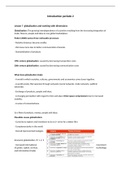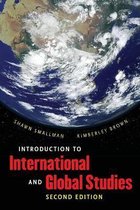Introduction periode 2
Lesson 7 globalization and working with dimensions
Globalization: The growing interdependence of countries resulting from the increasing integration of
trade, finance, people and ideas in one global marketplace.
Potter (2008) names three noticeable processes:
- Relative distances become smaller.
- We know more due to better communication channels.
- Standardisation of products.
19th century globalisation: caused by decreasing transportion costs
20th century globalisation: caused by decreasing communication costs
What does globalization imply:
- A world in which societies, cultures, governments and economies come closer together.
- A world society that operates through networks (social networks, trade networks, political
networks).
- Exchange of products, people and ideas.
- A changing perception with regard to time and place (time-space compression) due to increased
mobility.
- A sense of connectedness.
So a flow of products, money, people and ideas.
Plausible causes globalization:
- Curiosity to explore and inventions to do so (+ strive for a better life)
- Complementarity in the world
- Overall improved technologies
Economic globalization 1, 2, 3
- Increased international movement
of goods, capital, services, technology
and information (trade)
,- Establishment financial institutions (Bretton Woods)
World Bank (low interest loans)
IMF (stable exchange rates between currencies)
WTO (promote free trade, rules trade restrictions)
- Division of labour (global commodity chains)
Cultural globalization 4, 7
Ethnoscapes (landscapes of persons)
- Intentionally: migrants, students, tourists
- Unintentionally: refugees, asylum seekers
- Cultural mixing, increase diaspora, spread of diseases, xenophobia.
- Mediascape and Ideoscape changed by flows of information internet, music, TV, books,
newspapers, sports etc.
Technoscapes (landscapes of technology)
Financescape (landscape of fiscal and investment)
Mediascape (landscape of media distribution)
Ideoscape (landscape of political images)
Political globalization 5, 6
Political integration via political cooperation (boost after WW II).
UN has solved many wars, critique (US dominance, unending bureaucracy, not playing into
new balance of power).
International Law has grown in power
Human Rights has grown as an ideal
Democratisation has grown as dominant political trend
Rise of powerful IGOs and NGOs
Debate within nation-states for more or less power to regional organisations.
Four reasons why you could say globalization leads to more cohesion (= convergence) in the world:
- More countries have turned to capitalism/liberalism as economic system (eco.)
- Standardisation of products (eco.)
- More political cooperation than ever before (pol.)
- Integration / cultural mixing of people and ideas – homogenous human race (soc.-cul.)
Four reasons why you could say globalization does not lead to more cohesion in the world:
- National or local cultures resist when their own culture is being threatened –heterogeneous (soc.-
cul)
- Companies take local differences into account when marketing their products: “local differences
may be explored and exploited wherever possible” = glocalization (eco.)
- Liberalisation of world trade has led to many global protests / anti globalism (pol.)
- Political coopertions collapse (Brexit, Trump and his previous trade wars, etc.) (eco./pol.)
, Conclusion:
- In the last centuries we have experienced an ongoing and deepening form of globalisation.
- Visible in the political, economic and social-cultural domain/dimension.
- With on the one hand effects that have let to more unity in the world, and on the other hand
causing more disintegration.
- With a current debate whether globalisation has come to an end or is more alive than ever before.
Globalisation and working with dimensions Smallman & Brown, ch.3-5
Chapter 3 economic globalization
World Bank:
- Originally created to help Europe recover from World War II
- Later the focus was to helping the developing world (The Global South)
- The bank makes low-interest loans to qualifying countries, which can use the money for
development projects. The World Bank lends at rates lower than commercial bank rates. Its typical
loans were initially designed to increase infrastructure capacity. These loans come with conditions
imposed on them according to “restore or maintain balance of payments viability and
macroeconomic stability, while setting the stage for sustained, high-quality growth’. 3 key
dimensions to these conditions:
1. Privatization
2. Deregulation (removes policies that create trade barriers and competitive pricing)
3. Implementation of austerity measures that decrease the size of the government’s public-sector
spending on social services and education
IMF:
- Established to create stable exchange rates by pegging currencies to the U.S. dollar, which in turn
was pegged to the price of gold (that link to gold is now unfrozen)
- Stable currency exchange rates created the predictability necessary for global businesses to trade
- IMF primary role is intended to focus on macroeconomic issues, these include a country’s budget
deficit, its monetary policy, its inflation, its trade deficit and its borrowing from abroad
- Countries that join the IMF are assigned a type of quota based on their global economic position,
the balance of loans received must be repaid within five years.
Distinction between the World Bank and the IMF:
The World Bank focusses on micro-economic policy and the IMF on macroeconomic policy.





